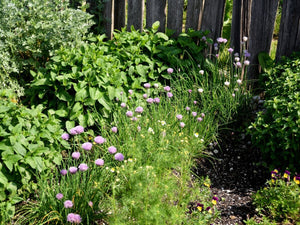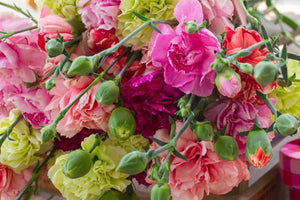Creating Floral Wreaths from Your Garden
CraftsFrom light and airy vines to masses of greenery with big showy flowers, wreaths can be a beautiful way to showcase your cut flower garden. There are endless ways to arrange flowers to create wreaths. Once you know a few basic methods, you can practice with all the materials you’re growing in your very own garden.

How to Make a Wreath
What You'll Need
- A wreath base (or make your own)
- Wire cutters
- Floral wire
- Hot glue gun (optional)
- String or raffia
- Scissors
- Focal flowers, filler flowers, and greenery
- Embellishments, like ribbon or gourds (optional)
First, you need to start with a base. Your base can be homemade or purchased from a craft store. Whether you use metal, wood, straw, foam, or even vines for your base is up to you.
If you choose to make your own wreath, look for vines, twigs, and branches that bend easily and will hold their shape without breaking when they dry. Some possible options are willows, ivy, Virginia creeper, and grapevines.
To create the wreath, cut branches or vines in lengths long enough to form a circle. Popular wreath sizes are 16" or 18" in diameter for a front door, or you can make a smaller 12" wreath for interior decor.
Once you have your general size determined, you can braid or intertwine the lengths of material to make the wreath thicker. Then use wire to hold the ends together.
Now that you have your base, you can start getting creative!
Adding Flowers

The next step is to add flowers. You can make small bundles or bouquets of flowers that can be attached to the wreath. This method will give you a fuller, more organic-looking wreath.
Using the basic elements of flower arranging, these bundles can have a focal flower, filler flowers, and greenery. Tie each bundle with raffia or string to hold them together, and then clip the ends so they are even.
Attach the bundles to the wreath one at a time while going around the circle in one direction. Overlay them a little to hide the ends.
Depending on the flowers and wreath type, they can be attached with string, wire, or hot glue.
Types of Wreaths
Fresh Flowers

Fresh flowers can be used in a variety of wreaths, from delicate daisy chain crowns to lush and formal arrangements. Fresh flowers in wreaths won’t last long when they don’t have water, so consider using floral foam soaked in water if you want a longer-lasting wreath. But even without the foam, fresh flower wreaths are lovely to craft for special events or just for fun.
The simple joy of a flower crown will only last for a day, but it is worth the extra effort. You can tie bundles of flowers to a simple base or hoop, or wrap the blooms around each other in a circle by tying the stems together with a little ribbon or string to secure them. They are lovely in photographs, at weddings, and used as centerpieces at special events.
Another fun method for crafting floral wreaths is to make a daisy chain. To make one, pick flowers with long, thick stems. About 2/3 of the way down the stem, use a toothpick or your fingernail to poke a hole in the stem. Next, thread another flower through the hole. Continue this until you have a long enough string of flowers to fit on your head.
Dried Flowers

There are endless ways to arrange dried flowers to create an everlasting wreath. One of the benefits of wreaths made from dried flowers is that they can be enjoyed for many years to come.
A very basic but pleasing design idea for floral wreaths is to use only the flower blossoms. Each bloom is glued or wired to the wreath to make a uniform, compact wreath. For example, a wreath made entirely of dried hydrangeas or sunflowers. This style can be used for all seasons of flowers.
Another fun wreath design to try is using dried herbs. Take bundles of herbs and attach them with raffia to a vine wreath. The finished design can be full and heavy or whimsical with sparsely spaced bundles of herbs between vines. Lavender wreaths are lovely, as are wreaths made of sage.
Dried grasses like wheat and rye can make a beautiful fan arrangement when splayed out around a circle.

From budding branches to evergreens, flower wreaths can be used in all seasons. And they don’t just have to be displayed on the door or the wall. Flower wreaths can be placed on tables and then filled with embellishments like Easter eggs, gourds, mini pumpkins, pinecones, and candles. Or they can be worn like floral crowns and daisy chains. The creative options are endless.
Popular Posts
-

Perennial Herbs We Love to Grow that are Perfect for Beginners
-

How to Grow Long-Lasting, Fragrant, Heirloom Carnations







Leave a comment